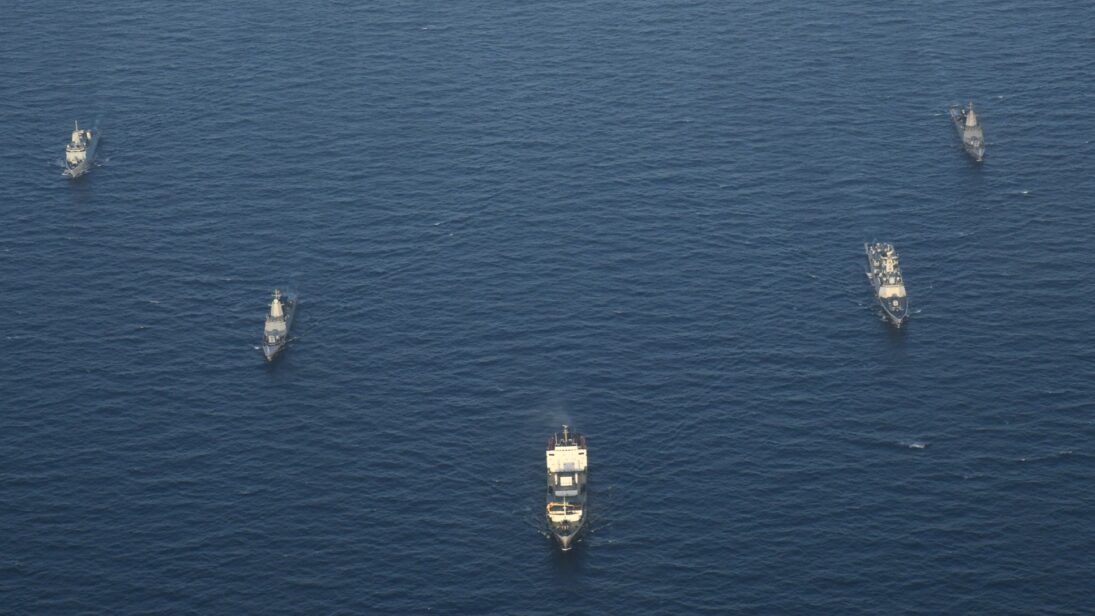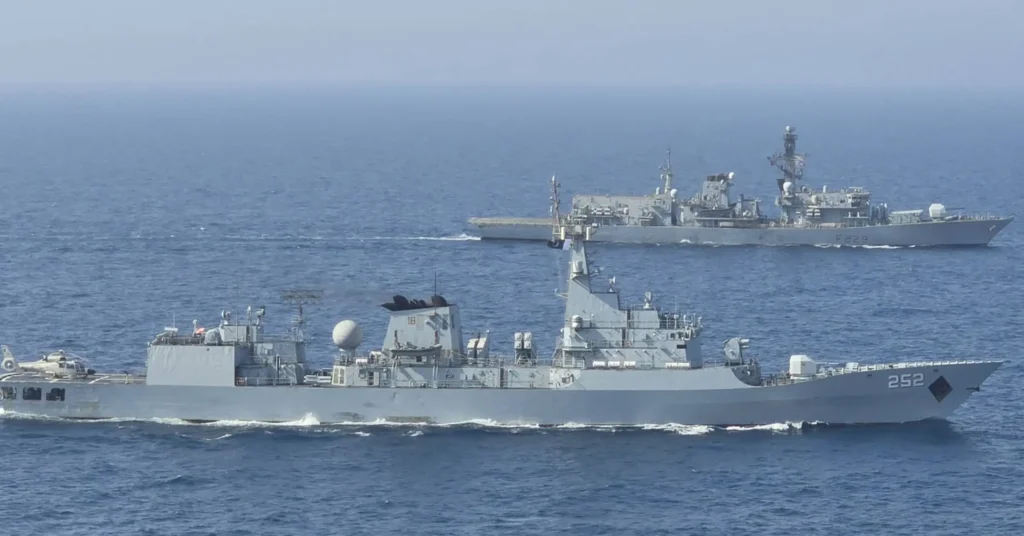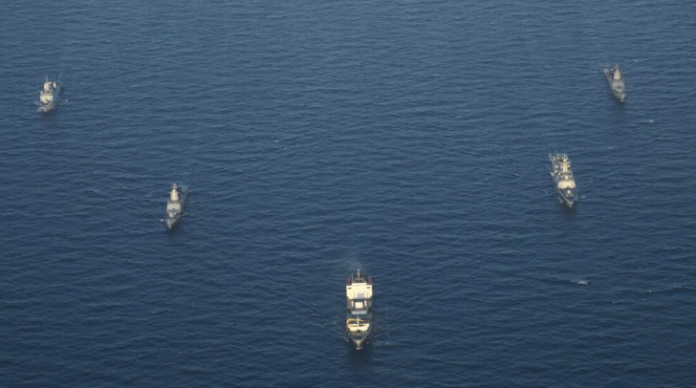
The Indian Ocean is at the heart of an evolving maritime security crisis. The region is witnessing an exponential rise in both legitimate and illicit maritime activities, stretching its governance and enforcement capacities thin. Meanwhile, geopolitical contestation, technological disruptions, and legal ambiguities further complicate an already fragile security landscape. Without a coordinated and inclusive response, the Indian Ocean could become increasingly unsafe for the free flow of regulated commerce.
The Blue Stretch Problem: Balancing Growth and Crime
The rise of the blue economy—driven by increasing maritime trade, which is set to triple in volume by 2050—has been accompanied by an equally strong but opposite surge in blue crime, including human and narcotics trafficking and piracy. But Indian Ocean states’ corresponding capacity to efficiently handle these maritime activities and comprehensively safeguard maritime commerce, such as through coordinated maritime law enforcement, is struggling to keep pace.
The Indian Ocean suffers from fragmented maritime governance, with many information-sharing centers and command constructs but a lack of connectivity and fusion between them. This is unlike the global aviation sector, where air traffic control functions seamlessly across regions. The global maritime security architecture itself lacks a suitable single top-level structure, such as at the United Nations level, to look at the entire domain as a whole. Flowing from that, there is no body or mechanism that can set and implement a regional agenda for the Indian Ocean.
The global maritime security architecture itself lacks a suitable single top-level structure, such as at the United Nations level, to look at the entire domain as a whole. Flowing from that, there is no body or mechanism that can set and implement a regional agenda for the Indian Ocean.
Geopolitical Fault Lines at Sea
The ocean has long been a battleground for great power rivalry, but today’s geopolitical contestation is finding space in the maritime grey-hybrid zone due to the lack of an effective maritime security architecture. Chokepoints compound the effects by making developments in a given region have global impact. With ongoing pinprick attacks on merchant ships in the Persian Gulf and Red Sea through proxies, the destruction of the Nord Stream subsea pipeline, and drone attacks on oil and gas infrastructure in the Middle East, the challenge of differentiating between non-state actors and state proxies at sea has become magnified.
In this context, plausible deniability with respect to threats to maritime security has become a serious problem. For instance, if a ship is grounded in an important waterway due to hacking by an unknown actor but it is impeding the transit of a carrier battle group enroute to a crisis zone, how should the affected state respond? Would this be considered a maritime safety issue, a blue crime, or an attack on national security? The challenges of fragmented maritime governance and insufficient successful collaborative maritime security initiatives provide no help in this regard.
The Rise of Blue Robocops and the New Digital Battleground
The maritime domain is undergoing a technological revolution with the proliferation of artificial intelligence (AI)-driven surveillance, robotic vessels, and satellite-based maritime domain awareness (MDA) systems. While these innovations enhance monitoring and enforcement, they come with challenges. First, most littoral countries struggle to make sense of the limited data they collect through land-based sensors and are hesitant to share this limited data with others due to national security concerns and mistrust. Second, advancements in satellite-based MDA, with the help of AI, have made blue crime visible, but they also risk enabling blue crime syndicates to develop cheap undersea capabilities and shadow MDA software.
Way Forward
Rethinking Maritime Security in the Indian Ocean
The principal reason for the gap-riddled maritime security architecture in the Indian Ocean is the state-centric and exclusive security community approaches by the maritime powers. A paradigm shift is required toward a more inclusive, human-centric model that builds trust among regional actors.
Despite geopolitical divides, nations can collaborate on the least common denominator, such as maritime safety, disaster relief and livelihood for coastal communities. The Incidents at Sea Agreement, Code for Unplanned Encounters at Sea, Indian Ocean Naval Symposium, and Combined Maritime Forces all provide successful models for cooperation. Using these same models, there is a need to conclude a future Code for Operating Unmanned & Autonomous Surface and Underwater Craft in the region.

Although the International Maritime Organization (IMO) has taken the lead in developing a code for maritime autonomous surface ships in a structured way, the timelines are too long–if all goes well, a mandatory code could only be enforced by January 2032. Such a long delay in the operationalization of a code could be tantamount to being too little, too late.
Another problem is that being a maritime regulator, the IMO is only concerned about autonomous merchant ships and may not address the unmanned surface vessels (USVs) and/or unmanned underwater vessels (UUVs) for exclusive military use. Since military USVs/UUVs also pose a threat to shipping, the IMO must take the lead and bring navies and coast guards of the region onboard to expedite a comprehensive civil-military Code for Operating Unmanned & Autonomous Surface and Underwater Craft, on the lines of the 1972 International Regulations for Preventing Collisions at Sea. Such a code may include, inter alia, the universal definition of an unmanned /autonomous craft, mandatory safety distances and standards for fail-safe remote datalinks.
Trust Over Technology
Trust building is more important than capacity building. As more foreign funding goes into building maritime security capacity of regional countries, especially software for MDA, the more mistrust it may engender in the recipients regarding security of information and its intended political use by the powers providing the software. The multiplicity of commercially available MDA software (e.g. IORIS and SeaVision) could complicate problems of fusion, interoperability, and access due to capacity constraints for some of the smaller IOR states. Instead, an Open-Source-Open-Access (O2SA) approach can ensure more equitable and independent access to white shipping, thereby singling out the bad guys.
From the point of view of having a common operating picture, a modest beginning has been made for connecting regional Information Fusion Centers, but a lot more remains to be achieved. However, solutions that rely solely upon high-tech approaches are unlikely to succeed. There is a parallel need to identify low-tech solutions, including human intelligence through community and local engagement.
Legal Reforms and Enforcement
Despite interdiction of many drug traffickers on the high seas, effectively prosecuting them remains a challenge, largely due to the absence of requisite legislation. States or maritime law enforcement agencies interdicting drug smuggling on the high seas do not enjoy the same universal jurisdiction as in the case of piracy. Consent from the vessel’s flag state is required before boarding, which may incur significant delays. The drug traffickers, and often their boats, thus re-appear on the scene in due course.
By prioritizing trust, inclusive governance, and proactive legal reforms, the Indian Ocean can become a model for cooperative security—rather than a theater of conflict and unchecked crime.
Just as international legal frameworks evolved to combat Somali piracy, similar efforts are needed to evolve comprehensive legal frameworks for interdiction of drug trafficking, illegal fishing, and cyber threats in the maritime domain. Since these issues are trans-national, the United Nations and its relevant agencies would have to take the lead for the global waters, and the Indian Ocean in particular, to be made safe for commerce and trade.
Conclusion
Maritime security in the Indian Ocean stands at a crossroads. If states fail to act collectively, the blue stretch between economic growth and maritime crime will widen, endangering regional stability. However, by prioritizing trust, inclusive governance, and proactive legal reforms, the Indian Ocean can become a model for cooperative security—rather than a theater of conflict and unchecked crime.
The article appeared in the southasianvoices

